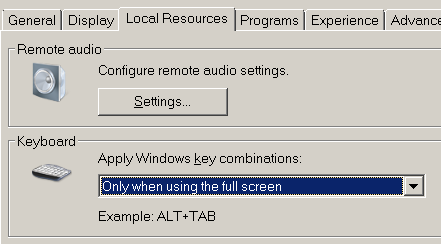MSTSC.exe
Connect and login to a remote machine using the Remote Desktop Protocol (RDP) also known as Terminal Server Connection (TSC).
Syntax
MSTSC [connection_file] [/v:server[:port]] [/g:gateway] [/admin] [/f[ullscreen]]
[/control] [/noConsentPrompt] [/edit "connection file"] [/w:width /h:height] [/multimon]
[/prompt] [/public] [/shadow:sessionID] [/span] [/restrictedAdmin] [/remoteGuard]
Options
"connection_file" The name of an .RDP file to use for the connection.
/v:server[:port] The remote PC to which you want to connect.
/g:gateway The RD Gateway server to use for the connection.
This parameter is only read if the endpoint remote PC is specified with /v.
/admin Connect you to the session for administering a remote PC.
/control Allow control of the session when shadowing.
/noConsentPrompt Allow shadowing without user consent.
/edit Open the specified .RDP connection file for editing.
/f[ullscreen] Start Remote Desktop in full-screen mode.
/w:width Width of the RDP screen
/h:height Height of the RDP screen
/multimon Configure the Remote Desktop Services session monitor layout to be identical to the current
client-side configuration.
/prompt Prompt for your credentials when you connect to the remote PC.
/public Run Remote Desktop in public mode. In public mode, passwords and bitmaps are not cached.
/shadow:sessionID The ID of the session to shadow.
/span Match the remote desktop width and height with the local virtual desktop, spanning across multiple
monitors, if necessary. To span across monitors, the monitors must be arranged to form a rectangle.
/restrictedAdmin
Connect you to the remote PC in Restricted Administration mode.
In this mode, credentials won’t be sent to the remote PC, which can protect you if you connect
to a PC that has been compromised. However, connections made from the remote PC might not be
authenticated by other PCs, which might impact application functionality and compatibility.
This parameter implies /admin.
/remoteGuard
Connect your device to a remote device using Remote Guard.
Remote Guard prevents credentials from being sent to the remote PC, which can help protect your
credentials if you connect to a remote PC that has been compromised.
Unlike Restricted Administration mode, Remote Guard also supports connections made from the remote
PC by redirecting all requests back to your device.
To connect to a remote computer the user account must be a member of the local group 'Remote Desktop users' on the remote server (either directly or inherited via a global group) in addition the user account needs the privilege SeRemoteInteractiveLogonRight (allow logon through RDP/Terminal Services.)
The command CMDKEY can be used to setup/save the password credentials used by Remote Desktop.
Shortcut Keys
Shortcut keys that can be used when connected to a Remote Desktop:
| Windows Shortcut |
Remote Desktop |
Description |
| Ctrl+ALT+Del |
Ctrl+ALT+END |
Bring up the Windows Security dialog box - this allows changing your password.
Alternatively run C:\Windows\explorer.exe shell:::{2559a1f2-21d7-11d4-bdaf-00c04f60b9f0} |
| ALT+TAB |
ALT+Page Up |
Switch between programs from left to right. |
| ALT+Shift+TAB |
ALT+Page Down |
Switch between programs from right to left. |
ALT+Esc
ALT+Shift+Esc |
ALT+INSERT |
Switch between programs in the order they were started. |
| Ctrl+Esc |
ALT+HOME |
Display the Start menu. |
| n/a |
Ctrl+ALT+BREAK |
Switch the client between full-screen mode and window mode. |
| ALT+Space Bar |
ALT+Delete |
Displays the remote window’s Control menu |
| ALT+Print Screen |
Ctrl+ALT+NumPad MINUS |
Place an image of active window onto the Terminal Services clipboard. |
| Print Screen |
Ctrl+ALT+NumPad PLUS |
Place an image of the entire TS client on the Terminal Services clipboard.
This is almost the same as pressing ALT+Print Screen to capute the window locally but removes the Windows chrome and so shows more of the remote window. |
If the RDP shortcut keys don’t work - this is dependent on your RDP options/settings.
The window may need to be full screen to accept shortcut keys.

All the RDP connection settings can be saved to a .rdp file, which you can then run from a shortcut:

The default settings are saved in default.rdp, you can also edit the .rdp file, the settings while scarcely documented all in plain text.
Examples
Connect to MyServer as admin:
MSTSC /v:MyServer /f /admin
Connect to an ip address with a 1024px wide display:
MSTSC /v:127.0.0.1 /w:1024 /h:768
Connect to MyServer with a 800px wide display:
MSTSC /v:MyServer /w:800 /h:600
Connect using a saved .RDP file:
MSTSC /edit filename.rdp
Error: "Your credentials did not work"
This error can have several causes:
If using a domain account, prefix with the domain name: SS64dom\user64
If the account is a non-administrator, you may need to grant logon rights as described above.
If the password contains any special characters: $,/,\, Tabs etc then copy and paste of the password to an RDP session may not work.
Specific problems: copy/paste will convert TABs into spaces and double $$’s are removed (e.g. Pa$$word1)
“Ignorance is preferable to error; and he is less remote from the truth who believes nothing, than he who believes what is wrong” ~ Thomas Jefferson
Related commands
Q216783 - Keep-Alive Disconnected TS Connections
Q2726399 - Cannot change the DPI setting through an RDP session.
MAPISEND - Send email from the command line.
RMTSHARE - Share a folder or printer.
SHORTCUT - Create a windows shortcut.
SHADOW - Monitor/View another users running RDP session.
SHUTDOWN - Shutdown the computer/Log off a user.
TSDISCON - Disconnect a Remote Desktop Session.
VMConnect - Connect to a Hyper-V Virtual Machine.
Microsoft Quick Assist - Based on the Remote Desktop Protocol, Quick Assist allows for remote viewing and control of another device.
Remote Desktop Services Shortcut Keys - Microsoft.
Equivalent bash command (Linux): VNCconnect or screen
Copyright © 1999-2024
SS64.com
Some rights reserved

